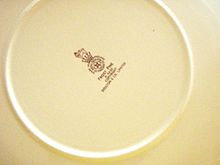- Royal Doulton
-
The Royal Doulton Company 
Type Private company, part of a plc Industry Pottery Founded 1815 Founder(s) John Doulton, Martha Jones & John Watts Headquarters Stoke-on-Trent, England Key people Henry Doulton Website http://www.royaldoulton.com The Royal Doulton Company is an English company producing tableware and collectables, dating to 1815. Operating originally in London, its reputation grew in The Potteries, where it was a latecomer compared to Spode, Wedgwood and Minton. Its products include dinnerware, giftware, cookware, porcelain, glassware, collectables, jewellery, linens, curtains, and lighting.
Three of its brands are Royal Doulton, Royal Albert and Minton. Together, the three brands make up Doulton Home, which is now part of the Waterford Wedgwood group. Most of the pieces in these three brands are today manufactured in China.
Contents
History
The Royal Doulton Company began as a partnership between John Doulton, Martha Jones, and John Watts, with a factory at Vauxhall Walk, Lambeth, London. The business specialised in making stoneware articles, including decorative bottles and salt glaze sewer pipes. The company took the name Doulton in 1853.
By 1871, Henry Doulton, John's son, launched a studio at the Lambeth pottery, and offered work to designers and artists from the nearby Lambeth School of Art. The first to be enaged was George Tinworth followed by artists such as the Barlow family (Florence, Hannah, and Arthur), Frank Butler, Mark Marshall and Eliza Simmance. In 1882, Doulton purchased the small factory of Pinder, Bourne & Co, at Nile Street in Burslem, Staffordshire, which placed Doulton in the region known as The Potteries.
 The pulpit in St. Alban's Anglican Church in Copenhagen, Denmark, donated and manufactured by Doulton
The pulpit in St. Alban's Anglican Church in Copenhagen, Denmark, donated and manufactured by Doulton
When the Anglican St. Alban's Church was built in Copenhagen, Denmark, in 1887 with Alexandra, Princess of Wales as one of the driving forces, Doulton donated and manufactured an altarpiece, a pulpit and a font. They were executed in terra cotta with glazed details to the design of Tinworth.[1]
By this time Doulton was popular for stoneware and ceramics, under the artistic direction of John Slater, who worked with figurines, vases, character jugs, and decorative pieces designed by the prolific Leslie Harradine. Doulton products came to the attention of the Royal family. In 1901 King Edward VII sold the Burslem factory the Royal Warrant, allowing the business to adopt new markings and a new name, Royal Doulton. The company added products during the first half of the 20th century while manufacturing fashionable and high-quality bone china.
The Lambeth factory closed in 1956 due to clean air regulations preventing urban production of salt glaze. Following closure, work was transferred to The Potteries.
The headquarters building and factory of the Royal Doulton ceramics firm were in Lambeth, on the south bank of the Thames. This Art Deco building was designed by T.P.Bennett. In 1939 Gilbert Bayes created the friezes that showed the history of pottery through the ages. The factory building was demolished in 1978 and the friezes transferred to the Victoria & Albert Museum. The office building in Black Prince Road survives, complete with a frieze of potters and Sir Henry Doulton over the original main entrance, executed by Tinworth.[2]
Recent developments
On 30 September 2005, the Nile Street factory closed. Some items are now made in the parent company Waterford Wedgwood in Barlaston, south of the Potteries Conurbation. Almost all other Doulton pieces are made in China.
Royal Doulton Ltd (along with other Waterford Wedgwood companies) went into administration on 5 January 2009.
The future of the archives of Royal Doulton and Minton are unclear as a consequence of the acquisition of Waterford Wedgwood by KPS Capital Partners.[3]
See also
Notes and references
- ^ "About the Church". St. Alben's Church. http://www.st-albans.dk/about-us/about-the-church/. Retrieved 2010-02-26.
- ^ TQ3078 : Doulton building at Black Prince Road near Lambeth High Street
- ^ "Art Fund appeal for the Minton Collection". http://www.artfund.org/mintonarchive/. Retrieved 2009-11-05.[dead link]
External links
 Media related to Royal Doulton at Wikimedia Commons
Media related to Royal Doulton at Wikimedia Commons- Official Royal Doulton website
- Exploring Royal Doulton, Nile St. Factory Staffordshire
- Examples in the collection of the Museum of New Zealand Te Papa Tongarewa
Categories:- Ceramics manufacturers of the United Kingdom
- Companies based in Stoke-on-Trent
- Companies established in 1815
- English pottery
- History of ceramics
- Kitchenware brands
- Staffordshire pottery
- Waterford Wedgwood
- Privately held companies of the United Kingdom
- British Royal Warrant holders
- Edwardian era
- Victorian era
- 1815 establishments in England
Wikimedia Foundation. 2010.


